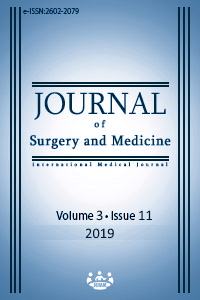Lower gastrointestinal endoscopic polypectomy: Cross-sectional study with 7503 consecutive endoscopic procedures
Keywords:
Colonoscopic polypectomy, Adenoma, AdenocarcinomaAbstract
Aim: Colonoscopic polypectomy is the most effective visceral cancer prevention tool in clinical medicine. Studies observed a 76-90% reduction in colorectal cancer incidence following colonoscopic polypectomy. We herein present a case series who underwent polypectomy by lower gastrointestinal system (GIS) endoscopy. Methods: The study population consisted of 7503 lower GIS endoscopy (colonoscopy or rectosigmoidoscopy) procedures performed in the Department of General Surgery between 2009 - 2019 for screening, diagnostic and follow-up purposes. 612 (8.2%) of the patients who underwent polypectomy were evaluated. The patients’ demographic data, clinical status, histopathology reports and follow-up findings were recorded. Results: During the study period, 612 patients (38 patients, twice and 3 patients, thrice) underwent polypectomy with lower GIS endoscopy. 386 of the patients were male and 226 were female. The mean age of the patients was 57.3 (13.7) (range 24-89) years. A total of 813 polypectomies were performed, and 118 procedures included two or more polypectomies. The most common sites of polypectomies were rectum (n=233, 29.5%), sigmoid colon (n=208, 25.3%) and the descending colon (n=107, 13%). Histopathological examination revealed 25 adenocarcinomas (4.1%), 98 high grade dysplasias (16%) and 269 low grade dysplasias (44%). In terms of histopathological results, there were no significant differences between genders (p=0.098), however, younger patients (mean age: 51.7 years (14.7)) were more likely to have benign results and malignity was more often encountered in older patients (p<0.001). The mean ages of patients with adenocarcinoma and high-grade dysplasia were 61.2 (12.1) and 63.6 (11.1) years, respectively. Necessary treatments and follow-ups were performed for the related pathologies. Conclusion: We observed that 8.2% of the patients undergoing lower GIS endoscopy had polyps and 20.1% of these polyps needed additional treatment, and 44% needed follow-up colonoscopy control. It should be noted that patients with various lower gastrointestinal tract symptoms may have malign polyps, potentially curable by polypectomy.
Downloads
References
Muto T, Bussey HJR, Morson BC. The evolution of cancer of the colon and rectum. Cancer. 1975:36;2251-70.
Winawer SJ, Zauber AG, Ho MN, O'Brien MJ, Gottlieb LS, Sternberg SS, et al. Prevention of colorectal cancer by colonoscopic polypectomy. The National Polyp Study Workgroup. N Engl J Med. 1993 Dec 30;329(27):1977-81.
Smith RA, Cokkinides V, Eyre HJ. American Cancer Society. American Cancer Society guidelines for the early detection of cancer, 2003. CA Cancer J Clin. 2003;53:27-43.
Konishi F, Morson BC. Pathology of colorectal adenomas: A colonoscopic survey. J Clin Pathol. 1982;35:830-41.
Boland CR, Hzkowitz SH, Kim YS. Colonic polyps and gastrointestinal polyposis syndromes. Gastrointestinal disease, Sleisenger MH, Fordran JSS, Philadelphia, WB Saunders Company 1989;2:1483-518.
Süleymanlar İ, Ertuğrul C, Işıtan F. Tanısal rektosigmoidoskopik incelemenin değerlendirilmesi. Turk J Gastroenterol. 1997;8(Suppl 1):28.
O’Brien MJ, Winaver SJ, Zauber AG, et al. The National Polyp Study: Patient and polyp characteristics associated with high-grade dysplasia in colorectal adenomas. Gastroenterolgy. 1990;98:371-9.
Williams AR, Balasoorriya BAW, Day DW. Polyp and cancer of the large bovel: A necropsy study in Liverpool. Gut. 1982;23:835-42.
Altınparmak E, Sezgin O, Parlak E, Altıntaş E. Colorectal polyps ‘The Yüksek İhtisas experience’. Turk J Gastroenterol. 2001;12:49-52.
Vatn MH, Staisberg H. The prevalence of polyps of the large intestine in Osio: An autopsy study. Cancer. 1982;49:819-25.
Eminler AT, Sakallı M, Irak K, et al. Gastroenteroloji ünitemizdeki kolonoskopik polipektomi sonuçlarımız. Akademik Gastroenteroloji Dergisi. 2011;10:112-5.
Granqvist S, Cabrielsson N, Sundelin P. Diminutive colonic polyps clinical significance and managemant. Endoscopy. 1979;11:36-42.
DiSario JA, Fautch PG, Mai HD, et al. Prevalence and malignant potential of colorectal polyps in asymtomatic, avarage-risk men. Am J Gastroenterol. 1991;86:941-5.
Bech K, Kronborg O, Fenger C. Adenomas and hyperplastic polyps in screening studies. World J Surg. 1991;15:7-13.
Lieberman DA, Smith FW. Screening for colon malignancy with colonoscopy. Am J Gastroenterol. 1991;86:946-51.
Downloads
- 918 1318
Published
Issue
Section
How to Cite
License
Copyright (c) 2019 Fatih Başak, Yahya Kemal Çalışkan, Sırma Tilev, Abdullah Şişik
This work is licensed under a Creative Commons Attribution-NonCommercial-NoDerivatives 4.0 International License.
















